Karate is a martial art, it can be seen as a sporting activity or much more. In fact, if you are interested in the philosophy and values that are part of karate, you can apply them in your daily life. THE moral values promoted by Karate teachers (Sensei), they make you understand respect for opponents, on the mat and in life, to remain worthy in both victory and defeat. Likewise, thanks to the color belt code, the karateka becomes aware of the established hierarchy and of his own progress.
Il karate is a martial art with bare hands which allows, thanks to a rational training, to educate the body and mind to respond to any type of aggression. In fact, the practitioner has a wide technical range based on the use of natural weapons of the human body: feet, hands, knee, etc. Furthermore, it is regarded as a extremely effective defense technique, so much so that it has been introduced into the armed forces and police forces throughout the world.
Finally, this discipline has had to "fight" a lot to have a place of honor in the sport because it will make its first appearance only in Tokyo Olympic Games in 2020.
Karate is a heritage, a culture, a way of life that is passed on from one generation to the next. Its strength is that it is a concept of life: the way of the empty hand.
Karate: what is it
It is a combat sport practiced with bare hands, as its etymology clearly expresses.
Karate is a Japanese term consisting of 2 characters: kara, which means empty, and you which means hand: empty hand, which is a discipline that is practiced without weapons.
Furthermore, it is a Japanese martial art that combines several defensive and offensive fighting techniques. In fact, he opposes 2 challengers who have the intent to attack or control the opponent.
Il karate is based on muscle strengthening and a search for the effectiveness of the body (power, elasticity, agility, etc.) and therefore can be considered as a complete martial art. However, the further you go in the practice, the more you develop the intelligence, wisdom and control that will then prevail over physical abilities. In fact, the more you practice, the more you consolidate the mental aspect.
This discipline allows you to focus your energies and to transform aggression into a controlled combativity that you also need in life.
The main goal of the practice is not to win but to practice assiduously to mold and shape the character.
“Remain humble when I win and persevere when I lose”: this is the philosophy of Budo (traditional Japanese art).
Sports karate
In Sports Combat, regulated by various international regulations, the following techniques are absolutely prohibited:
- strangulations
- mild
- blows to the vital points
- blows with an open hand, with the knees, with the elbows.
They are allowed, always with control:
- Calci
- Fists
- Projections.
Competitions
Kata
Il kata (form) is a sequence of techniques performed by a karateka facing an imaginary opponent. There are 2 types of competitions in kata: individual and team. In martial arts, kata represents the forms of combat played with one or more imaginary opponents. It is strictly coded.
The study of kata has as its objective the work of:
- embusen: imaginary axis
- technique (preparation, precision, positions)
- energy (kime, explosiveness, kiaï)
- rhythm
- chakugan (concentration, vigilance).
kumite">kumite
2 opponents face off on a tatami, each is equipped with protections and has a red or blue belt to be easily differentiated by both the public and the referee.
Il competition rules admit a slight contact at the abdominal level, but no contact to the face with punches and kicks. It is possible to defend oneself with parries and dodges.

Benefits of Karate
Kids
Psychological benefits
Limportance of the moral code of karate and the values of martial arts, accompanies the child in the recognition of authority. Indeed, in karate, the master represents the discipline and the child is induced to adapt his behavior following some rules. Not only that, karate teaches how to manage emotions and anger, thanks to precise rules and to acquire a "philosophy" that tends to combine body and spirit, physicality and moral values.
The Sensei emphasizes the work of psychomotor skills with fun but repetitive exercises to promote concentration and make every child participate.
Physical benefits
From a physical point of view karate:
- strengthens the bone, joint and muscle structure
- improves and refines coordination
- teaches diaphragmatic breathing
- develops, over time, an extraordinary readiness to react and a high degree of attention and concentration.
Hence, children who practice this discipline benefit greatly from it. Indeed, this discipline is able to develop both motor and cognitive skills leading the student to develop a full awareness of his or her body even when it is in motion.
In addition, it is a fighting and defensive physical activity that helps the child to develop:
- cerebral lateralization
- elasticity
- equilibrium
- speed
- orientation in space
- respect for others
- strictness
- self confidence
- discipline.
Karate to fight the disease
All 'Bambin Gesù pediatric hospital in Rome, have opened karate lessons to children with cancer and other chronic diseases to teach them to better manage disease and pain. Indeed, karate gives strength, courage and serenity.
Find out more.
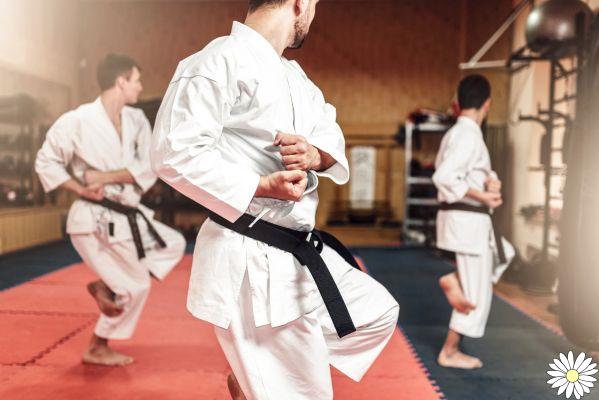
Physical and psychological benefits for all ages
Karate is good for children but also for adults elderly, to males and females, to the strong and the weak precisely because this discipline is not just a sport but aart that trains mind and spirit.
The goal of karate is not so much in the victory of the fight but in the achievement of a synthesis: technical perfection and inner balance.
It's good for your muscles and joints
From adolescence onwards, karate exercises allow you to build an excellent muscle base. In addition, they work the different muscle groups and thus strengthen the joints. Furthermore, the muscle work is important because it exploits both isometric work (position) and plyometric work (displacements).
It's good for the heart
In practice, the karateka has gods benefits to the cardiovascular system thanks to endurance work. Furthermore, many phases inherent in the practice of kata and kumite">kumite are explosive and for this reason they increase the heart's ability to handle important efforts short-term (anaerobic work).
In addition, karate reduces the risks of diabetes 2 because the karateka burns fat.
Improve coordination
In children, the karate improves space-time orientation, like knowing how to distinguish left from right. To this lateralization, there is also the verticality, of which the children gradually become aware (arms-legs). Finally, for everyone, the search for precision in gestures improves motor coordination as, for example, in the attack leg forward and arm back.
In kumite">kumite, students of all ages improve the perception of danger, that is the distance from which you can be attacked and the useful distance to attack.
In older people, the practice of karate improves the perception of space thanks to the work on lateralization, center of gravity and balance, reducing the risk of falls.
Improve self-esteem and self-confidence
Constant practice improves the energy capacity that consolidates the motivations. This results in greater awareness and self-control, thus overcoming, at best, the fear of getting hurt or doing harm.
Furthermore, the practice helps you fight irrational fears and makes you autonomous in stress management. In fact, the more tense you are, the more difficult it will be to execute sequences or fight. Karate teaches you to relax.
Develop respiratory qualities
In kata, the breathing is essential. It accompanies the movements and, for example if the exercise is slow, you need to perform a long and deep inhalation. In fact, thetraining promotes the expulsion of CO2. On the other hand, if done badly, the karateka can suffer from cramps.
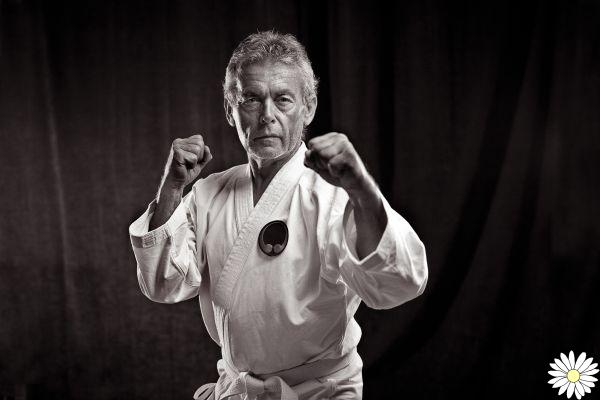
The history of karate and its ancient art
It was born on the island of Okinawa, in southern Japan, where a native form of combat has always been practiced, a sort of secret "martial art" that was transmitted by the nobles from generation to generation: Okinawa-te.
Certain news on the history of karate, beyond the legends and popular beliefs, yes they only have since 1600, when the socio-political conditions of the Okinawan nobles changed profoundly. They became impoverished and for this they were forced to devote themselves to trade and crafts. The result of this rapprochement between social classes was the dispersion of the ancient martial art, which was handed down, in order to survive, to a very small circle of elected members belonging to the lower class. L'Okinawa-te thus became the prerogative of many: the basics of modern karate.
modern karate
All projects birth of modern karate also contributed to the Chinese martial arts. Japanese travelers who went to China tried to learn the local martial arts, based mainly on one profound philosophy and a particular conception of the human body. Given the complexity of these techniques, it is possible that i Japanese gave it a personal interpretation, contaminating their original art, that of Okinawa-te and giving life to a discipline that slowly found canonical forms and codes.
Sokon Matsumura e Gichin Funakoshi
The founder of what was, in fact, Okinawan's first school of art was Sokon Matsumura. He taught the rudiments of the indigenous art of the island, the art of sword and Chinese martial arts practice.
Much later, in 1922, Master Gichin Funakoshi performed in Tokyo, thus exporting the martial art outside the island of Okinawa. Soon after, his pupil, Anko Itosu, had theintuition to include Karate in schools, thus giving way to the spread of this art, ready to be welcomed also in Western countries.
Certainly the karate practiced today is distant from the original spirit of its founders even if the aspect that reconciles mind and body, psyche and physical remains fundamental.
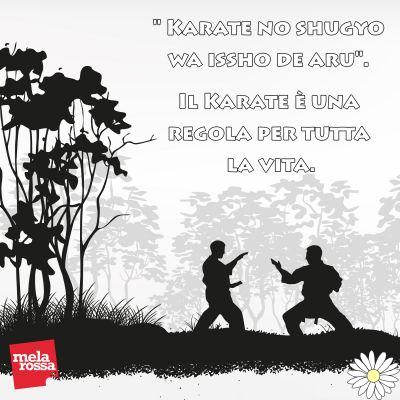
Principles of karate
LThe practice of karate includes all the nuances of life because it is a rule of life. Master Gichin Funakoshi declared it in 1956 but it remains valid today because the study of karate lasts a lifetime.
The student tirelessly repeats the same techniques to arrive at a perfection that he will probably never reach.
SHIN GI TAI means spirit, technique and body.
These 3 aspects must be developed in harmony. If the physical results are felt after a few months of practice, it is more complicated for those of the mind.
First, know a way to keep yourself physically fit and then open your heart and mind to free yourself from the prejudices of everyday life.
In karate it is important to first surpass oneself and then others.
That is, today you are better than yesterday but tomorrow you will be even better and this applies to everything you do. In fact, a Samurai spent his life perfecting himself and it was an endless process.
Anyone who has learned not to give up during fights and has managed to build an extraordinary mental strength, will not give up also facing the tests of everyday life. Therefore you will better manage the difficulties both on the mat and in life. In fact, karate helps you to always feel up to it.

Karate etiquette
Dojo means "place of life"
To sit in the dojo, there are 2 positions to adopt.
- The first is the position in seiza (kneeling).
- The second is the anza position (sitting cross-legged).
These 2 positions are allowed during the demonstrations, explanations or rest periods. Instead, it is forbidden to lie down on the ground or sit with your legs stretched out because these positions give the feeling of neglect. In fact, a karateka must always be attentive and respectful of the dojo.
Clothing should never be scruffy. It is important to adjust the Karategi (uniform) from time to time during training and it is mandatory to do this before each greeting.
Also, the belt knot must be done correctly.
For reasons of hygiene, walking on the tatami with shoes is prohibited. Zoori, typical Japanese slippers, must always be ordered outside the tatami.

Philosophy
The 9 virtues of Bushido
The word bushido means the "way of the warrior".
It is a code of honor and ethics that manages the whole of the martial arts.
The duty of every practitioner, whether he is a pupil or a teacher, is believe and interpret these principles to be a role model for others and convey the interest in martial arts but also the rules of "good behavior". Indeed, those who practice martial arts must be ambassadors of the discipline.
Onore: Meiyo
It is the essential virtue. Nobody can think of being Budoka (warriors in the noble sense) if he does not have an exemplary conduct. From the sense of honor, all the other virtues derive.
Loyalty: Chujitsu
There is no honor without loyalty and fidelity towards some ideals and those who share them. Furthermore, fidelity requires sincerity in words and deeds.
Sincerità: Seijitsu ou Makoto
Lying or misunderstanding engenders suspicion which is the source of all differences.
In karate-do, the greeting is the expression of this sincerity, it is the sign of one who does not disguise neither his feelings nor his thoughts but knows how to be authentic.
Courage: Yuuki ou Yuukan
La fortitude that is needed to defy danger and suffering is called courage. And it is precisely the courage that pushes you to be respected in all circumstances, what makes you right and that helps you, despite your fears, to face the trials.
Kindness and benevolence: Shinsetsu
Kindness and benevolence are signs of courage which denote a great humanity. They push you to help each other and to be attentive to others and to life.
Humility: ken
Goodness and humility cannot be sincerely expressed without balance. Being humble, devoid of self-importance and vanity, is the only way to be balanced.
Righteousness: Tadashi ou Sei
Loyalty, honesty, and sincerity are the pillars of righteousness. They also help you make a sensible decision with conviction.
Rispetto: Sooncho
Righteousness breeds respect for others: good education is the expression of the respect due to others, whatever their qualities, weaknesses or social position. Knowing how to treat others with respect it is the first task of a Budoka because it helps him to avoid problems and conflicts.
Self-control: Seigyo
Self-control is the essential quality of a black belt. In fact it represents the ability to control one's feelings, drives, instincts. It is one of the main objectives of karate-do because it conditions the incisiveness.
The Twenty Principles
Master Gichin Funakoshi, who founded Shotokan, expounded the Twenty Principles of Karate which contain, in full, the basic concepts of this art that combines skill, humility and patience, both internal and external. According to Funakoshi, compliance with these rules leads the karateka to improve physically and spiritually.
It was Master Funakoshi who wrote:

- Karate begins and ends with the salute
- it never attacks first
- karate is righteousness, gratitude, pursuing the path of justice
- it is first of all to understand oneself and then others
- the spirit comes first; technique is the ultimate goal
- loyalty and spontaneity; always be ready to free your mind
- it teaches you that adversity affects us when we give up
- you don't just live in the dojo
- Karate is for life
- the spirit must inspire all our actions
- it must be kept alive with the fire of the soul; it's like hot water, it needs constant heat or cold water will come back
- the important thing is not to win, but the idea of not losing
- victory lies in your ability to distinguish the vulnerable from the invulnerable
- concentration and relaxation must find their place at the right time; move and go along with your opponent
- hands and feet like swords
- think that the whole world can be your opponent
- the guard for beginners, the natural position for experts
- kata is perfection of style, its application is something else
- like the bow, the practitioner must use contraction, expansion, speed and similarly in harmony, relaxation, concentration, slowness
- make the spirit stretch to the highest level.

Styles of the World Karate Federation (WKF), recognized by the International Olympic Committee
Shotokan (Karate-Do). Founded by Master Gichin Funakoshi who he regarded karate as an inner discipline. It was taken as an example by various schools also undergoing various variations. It is still the most widely practiced style today. It is characterized by low, stable and strong positions (a more static style than the others). It includes both Kata and Kumite competitions.
Shitō-ryū, founded by master Kenwa Mabuni in 1931. He moved to Osaka in 1929 where he opened his own gym to teach his interpretation of Karate-Do. The name Shitō-ryū is none other than the set of initials of his most important masters. It is style that includes the greatest number of Kata.
Goju-Ryu: it is the oldest style of all, the one still practiced in Okinawa, where it originated. Goju-Ryu in Japanese means “hard-soft style“, Or“ school (ryū) of hardness (Gō) and compliance (jū) ”. Then alternate hard techniques with softer ones. The first Master was Kanrio Higahonna who lived for a very long time in China.
Wado-ryu: it is a modern style that blends Okinawan karate with a new element, Kumite. Wado-ryu means "The school of the Via della Pace". The positions are very high and soft, the distance between the opponents medium-short and the style gives great importance to the fluidity of body movements and speed.
The Shotokan Style in the world
In the sixties, the exponents of the Japan Karate Association, they decided to export Karate also to the West. To pursue this goal they sent Masters to Europe and the United States, true pioneers of international karate. The spread of this discipline was unstoppable, also aided by stages, competitions and seminars. In a short time, millions of people around the world practiced Shotokan karate.

Training
Karate training includes 3 basic phases:
Combinations Kihon
Il kihon is learning basic techniques and motor patterns that become more and more composite and complex with practice.
KI= radici e HON= base
This basic workout consists of:
- preparations
- attacks
- against attacks.
Unlike Kata, Kihon is not coded and can be practiced in several ways:
- Isolated movement.
- Dynamic and more complex sequences.
This practice helps the beginner to learn and acquire basic techniques. In fact, performing the basic techniques relentlessly ensures the acquisition of a complete gesture mechanics.
kata (shape)
Kata is a fight with imaginary opponents during which compositions and combinations of techniques (forms) are performed that require the utmost precision of execution. The key elements are:
- technique
- short and isometric muscle contraction
- power
- expressiveness
- rhythm.
For example, in Shotokan karate, i movements must be soft and deep. Movements in kata can also be applied with a real opponent during exercises called bunkai.
kumite">kumite
Kumite is the most used form of fighting in karate. It is based on foot-punching techniques. Learning is integrated in an evolutionary planning suitable for each level. The priority is to be able to perform the different techniques with control and following precise rules.
You get to free combat only when you have obtained the black belt, precisely because this requires perfect knowledge of techniques, physical and mental preparation and absolute control of the blows to avoid accidents.
The techniques used are of levers and projections. The hit does not aim to knock out the opponent but to express his potential.
Therefore, the techniques must always be performed with complete control.

How karate is practiced: Karate-gi and belt
To practice Karate, you have to have karate-gi, consisting of a jacket whose flaps overlap (uwagi), and gods white cotton pants (zubon).
The colored belt (obi) is worn over the jacket: each color corresponds to a level of acquired knowledge. The color of the belt can only be changed by passing the appropriate exams.
The colors of the belt

The passage of the belt
To have the belt of a color that indicates a higher level of skill it is necessary to perform, in front of a commission, an exam to prove the adequate competence acquired. Depending on the school you attend, the demonstration can be expected execution of forms (kata), self-defense and combat (kumite">kumite). The black belt exam it may also include a written test.
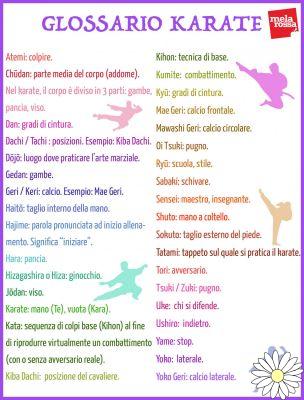
Karate technique
The technique consists in:
- preparations
- punches
- kicks
- strokes.
The positions
Positions are the basis for learning the technique. There are at least twenty of them that respond to the diversity of situations that a karateka can encounter. Among the various styles of karate, there are variations for the same position.
The fighting positions are, for each situation, the best compromise between stability and mobility. Stability is essential, both in attack and defense, to maintain balance and energy transmission. The low posture, like that of the knight, they are important to continue the techniques, react or stand still in front of the opponent.
Positions: some examples
1 -HEISOKU DACHI, in piedi, gambe unite.
THE Heisoku dachi is a waiting position which is adopted to make some greetings. The weight of the body must be distributed on both feet.
2 – TSURU ACHI DACHI (sagi ashi dachi) In piedi su una gamba.
It is a position of preparation of a leg technique. It cannot be kept for long because it is one unstable and vulnerable position.
3 - NEKO ACHI DACHI position of the cat.
It's a defensive or waiting posture which facilitates fast moving. There back leg is bent and bears almost all the weight.

Shifts
Il combat is a dynamic phase, during which the fighter is never static. Changes of guard, repositioning in front of the opponent, dodging, are moments of transition both in the supports and in the changes of position. Consequently, they are moments of relative vulnerability.
Then the shifts come designed to maintain balance. Each move has its own characteristics but there are common fundamental principles:
- maintain balance by keeping the center of gravity at a constant horizontal level
- keep the torso straight and the waistband solid
- the whole body performs the movement
- the impulse comes from the belly (Hara) and not from the torso or legs
- moving feet close to the ground.
Examples of displacements
1 - TSUGI ASHI pas chassé or slipped step.
It is undoubtedly the form of displacement most used in the race because it facilitates fast and medium-amplitude movements without changing the guard. It is used to adapt one's positioning in front of the opponent and then attack or dodge.
2 – AYUMI ASHI.
The back foot passes forward. The displacement causes a change of guard. This displacement allows powerful and wide-ranging movements.
3 - HIKI ASHI: Step back.
It's a normal step to be performed backwards.
The legs remain slightly bent when moving.
Defense techniques
First, the karate is an art of defense. This spirit is found in kata which all begin with a defense technique.
In martial arts, the concept of defense is very broad and it is sometimes difficult to distinguish it from attack. In fact, a parade has the double function:
- parry the attack
- prepare the counter attack.
In fact, at an advanced level, parries and attacks become confused.
In karate, there are:
- Go No Sen: block and counterattack
- Sen No Sen: action on intention.
La defense is therefore very complex and comes in a multitude of variants combining techniques of the legs or arms, shifts and parries.
Defense techniques: some examples
1 – JUJI UKE (kosa uke): parata con braccia ad X (KOSA UKE).
It's a double defense and very strong carried out with the 2 arms crossed at the level of the wrists to block a kick.
2 - TEÏSHO UKE: defense with the palm of the hand.
If you use the outer part of the palm to deflect attacks. It is a technique that requires great precision.
3 - SHUTO UKE: defense with the cut of the hand.
Locking with the open hand carried out from the inside out with the external cut of the hand. Shuto Uke is used against hits.
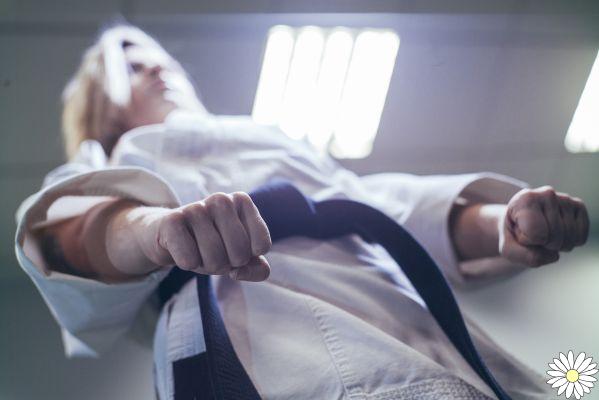
Attack with the arms
Le Atemi techniques (punches and kicks) are designed to disable the aggressor. the basic movements are few but they can be declined in a multitude of variations by combining movements and attacks.
Among the attacks on the upper part, the “tsuki”, direct punches, and the “uchi”, indirect blows, are distinguished.
Examples of attack
1 - USHIRO ENPI UCHI: attack with the elbow back.
It is used during close combat. The Ushiro (back) form also helps to get rid of a back grip.
2 - URA TSUKI: palm fist turned upwards.
Used in close combat when the amplitude is sufficient to perform fist rotation and arm stretch.
3 – THERE IS TSUKI pug with step (Jun tsuki).
It's a direct punch that is done during a step. The arm is extended forcefully as the foot touches the ground.
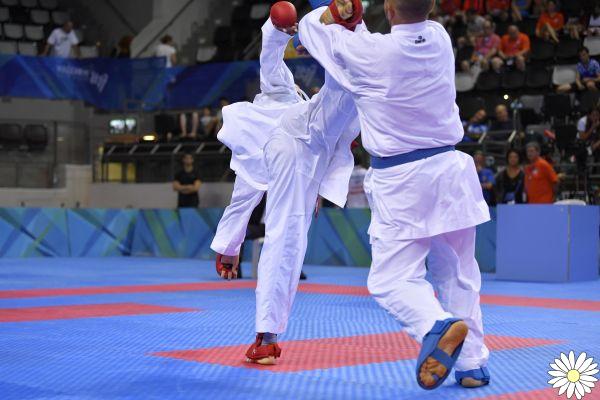
Legs
The techniques with the lower limbs have the double advantage of power and elongation.
However, the balance is precarious because, football, is carried on one foot or none, in case of jumps. Therefore, during learning, this limitation must be taken into account. In any case, you can apply some principles such as:
- keep the supporting leg slightly flexed
- heel to the ground
- keep the torso straight.
Each technique offers a variety of alternatives:
i kicks can be done with the back leg or the front leg. The first solution is more powerful while the second is faster.
There are 2 ways of striking:
- Kekomi: direct kick
- Keage: kick that follows an upward trajectory.
La choice of the alternative depends above all on the position and commitment of the fighters.
Some examples
1 - MAE GERI: frontal shot.
Powerful, wide-ranging stock to be used to hit an opponent in front of you.
2 - USHIRO GERI kick back.
It's a direct kick for the opponent who is behind you or who has voluntarily turned his back.
3 - YOKO GERI side kick.
Powerful football, made in lateral extension.
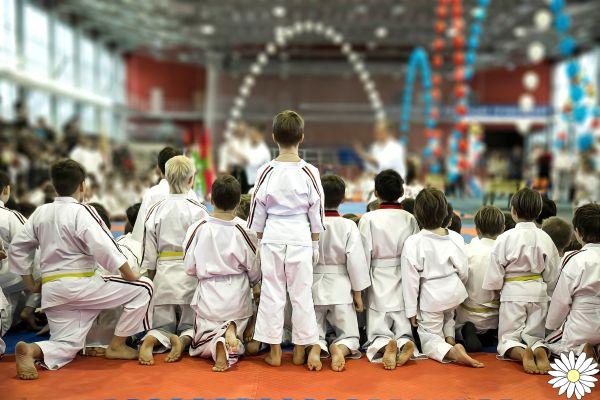
Sports karate
Sports Karate involves the practice of all styles of karate, practiced however not so much for their philosophical and martial vocation, as for their competitive aspect, aimed at competition.
Sport karate has a reference federation, the FOR YOU (Spanish Federation of Judo Fight Karate Martial Arts) which organizes competitions based on the age of the participants and the objectives.
The age classes in karate
In sports karate, athletes are divided into age groups. We therefore have the following categories (updated as of January 1, 2019):
- Children A: born in 2014/15
- B children: born in 2012/13
- Children: born in 2010/11
- Boys: born in 2008/09
- Beginners: born in 2006/07
- Cadets: born in 2005/04
- Juniors: born in 2003/02
- Seniors: born from 1982/2001
- Masters: born from 1953/1981
The Master category, in turn, is divided into further categories (A, B, C, D, E, F).
It becomes competitive athletes starting from the Beginners class up to the Seniores class.
Sports Karate in the world
Even at the international level, the year of birth counts in sports karate. The categories that can participate in international competitions are 3:
- Seniores: from the day of the 18th year of kumite">kumite and the 16th year of kata.
- Juniors: from the day of the completion of the 16th year to the day before the completion of the 18th.
- Cadets: from the day of the completion of the 14th year to the day before the completion of the 16th.
kumite">kumite in sports karate
Kumite practiced in competitive competitions is subject to precise rules. For this there are weight categories:
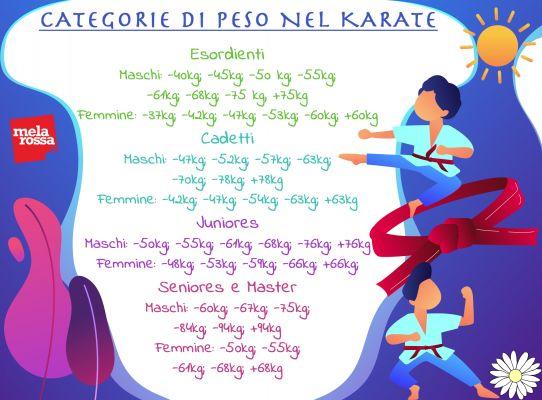
Duration of the fight
FIJLKAM also provides that the fighting duration changes according to age and to the category to which they belong:
- beginners: has a duration of 1 minute and 30 seconds
- cadets and junores: it lasts 2 minutes
- male and female seniors: it lasts 3 minutes.
The victory is decreed when at the end of the time you are in advantage or, before the end of the time, when you have a difference on the opponent of at least 8 points difference (for example 9 to 1).
If you want to learn more, read the regulations of the FIJLKAM.

Recommendations and contraindications
Karate is a complete sport and has many advantages and benefits for the mind and health. However, its contraindications are those of all dynamic sports. It is not recommended for:
- pregnant women
- those with cardiovascular and respiratory problems.
In any case, before practicing, ask your doctor for advice.
Finally, you need to know that the karateka can be exposed to accidental blows:
- nose
- eye
- lip
- joints
- showers
- fractures.
In collaboration with Enzo Denaro, Judo Master, 7th Dan and sports journalist specialized in Judo to Martial Arts.
.
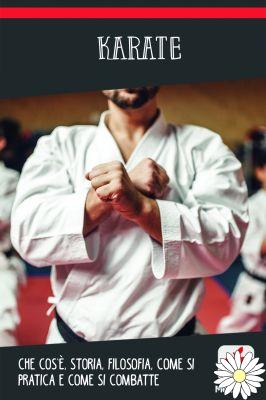
Learn more about this topic
- Tai chi: what it is, history and philosophy, how to practice, exercises and benefits for mind and body
- Ju Jitsu: what it is, philosophy, technique, training, benefits and contraindications
- Kick boxing: what it is, techniques and rules, history, benefits and contraindications
- Taekwondo: what it is, history, philosophy, training, benefits and contraindications
- Kung fu: what it is, history and philosophy, benefits and fighting techniques
- Capoeira: what it is, history, characteristics, how a fight takes place, dance, music and benefits
- Aikido: what it is, philosophy, training, clothing, benefits and contraindications
- Judo: history, philosophy and moral code, techniques and training, benefits and contraindications
- Global Self-Defense Method (MGA): what it is, how it works, for whom and why it is important to know how to defend yourself.

























